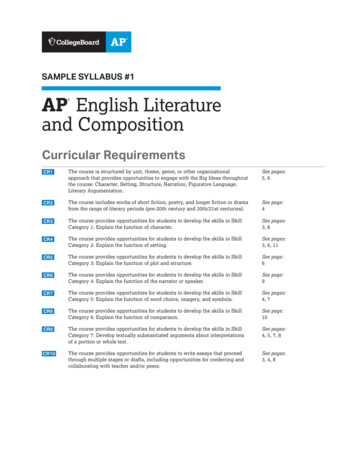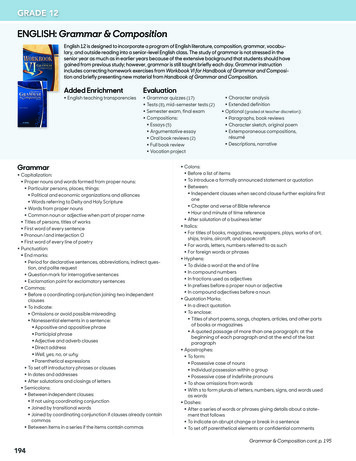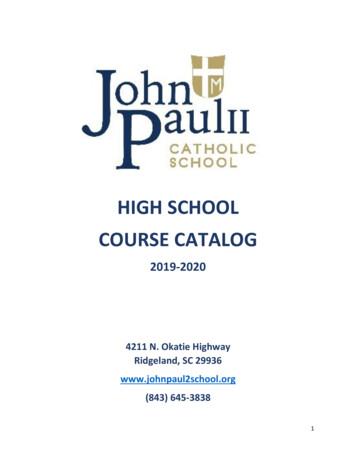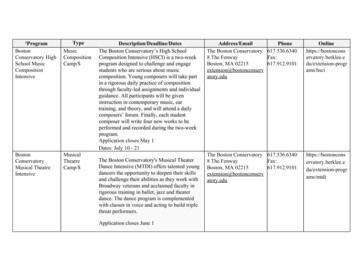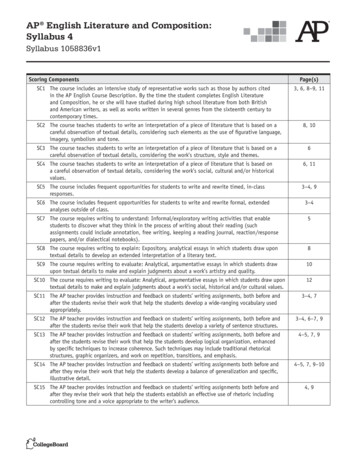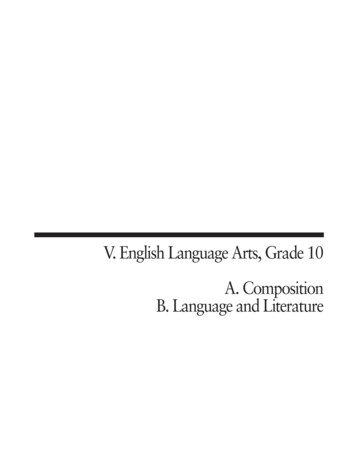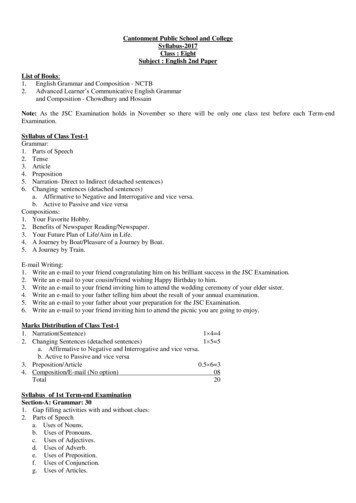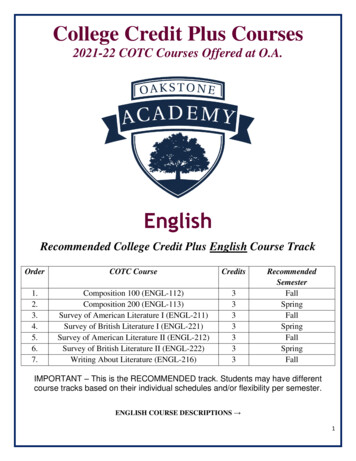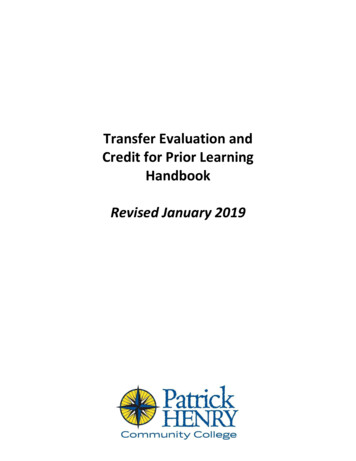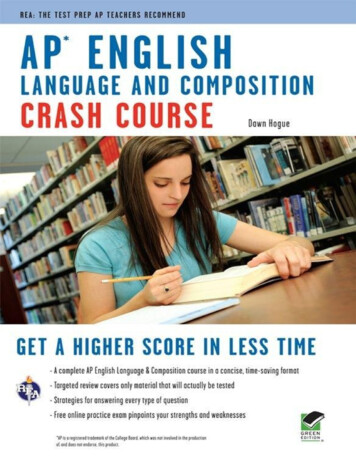
Transcription
AP English Literatureand Composition:Study GuideAP is a registered trademark of the College Board, which was not involved in the production of, and does not endorse, thisproduct.
Key Exam DetailsWhile there is some degree of latitude for how your specific exam will be arranged, every APEnglish Literature and Composition exam will include three sections: Short Fiction (45–50% of the total)Poetry (35–45% of the total)Long Fiction or Drama (15–20% of the total)The AP examination will take 3 hours: 1 hour for the multiple-choice section and 2 hours for thefree response section, divided into three 40-minute sections. There are 55 multiple choicequestions, which will count for 45% of your grade. The Free Response writing component,which will count for 55% of your grade, will require you to write essays on poetry, prose fiction,and literary argument. The Free Response (or “Essay” component) will take 2 hours, dividedinto the three sections of 40 minutes per section.The course skills tested on your exam will require an assessment and explanation of thefollowing: The function of character: 15–20 % of the questionsThe psychological condition of the narrator or speaker: 20–25%The design of the plot or narrative structure: 15–20%The employment of a distinctive language, as it affects imagery, symbols, and otherlinguistic signatures: 10–15%And encompassing all of these skills, an ability to draw a comparison between works,authors and genres: 10–15 %The free response portion of the exam will test all these skills, while asking for a thesisstatement supported by an argument that is substantiated by evidence and a logicalarrangement of the salient points. This section tests an ability to think critically, construct asolid argument, see many sides of an issue and, of course, write clearly, correctly, and with aconsistent focus on the subject.1
Selecting a subject for each essay is crucial. Only those works you arethoroughly familiar with, and which you have a strong sense of what theauthor’s purpose is should be the subject of the essay. Those works youparticularly like and which you can express your enthusiasm for are likely toresult in a positive reader response.The Advanced Placement examination is not an easy test, but a passing grade is a realisticexpectation and an achievable goal. If an engagement with literature has been important foryou throughout your high school years, and if your written responses to the texts you studiedhave developed through practice, revision and refinement, then the prospect for enrollment incourses beyond the preliminary requirements of the university you chose to attend is withinreach.The exam, in its most basic sense, tests the capability to read alertly, analyze with insight, andwrite about imaginative literature with style and clarity. This corresponds to the AP coursecurriculum, which is designed to deepen an understanding of how writers use language toprovide meaning and to evoke the pleasures of an engagement with the text.About this GuideThe goal of this guide is not to teach you the entirety of a literature and composition course—that would be impossible. Rather, it is designed to reacquaint you with the literature you haveexamined and explored, and to point toward analysis methods you can use while prepping foryour exam.This guide might be seen as an outline and overview of the larger purposes of the exam, and asa roadmap through its divisions. We will walk you through a few key pieces of literature andthen show you how they might be tested on the AP exam. We’ll then provide detailed answerexplanations so you can see the thought process that goes into answering AP questions.Let’s begin!2
Introduction to English LiteratureFrom the earliest moments of the nation state, survival literally depended on the force of armssummoned by warlords from every part of the population. The most powerful of these warriorsbecame the heroes of the tales that recounted their feats of bravery and valor. Achilles,Beowulf, and Gilgamesh were celebrated in oral accounts that were transposed into thenational epics that formed the first enduring literary efforts of these proto-nations. Thefamiliarity of these folk tales, shaped into literature, drew the attention of leading publicintellectuals like Aristotle, whose commentaries became the first versions of the literary essays,which have been inextricably linked to the works that constituted a national heritage.The heroes of these epics would have been lost to history without the creators of theirmemorable stories. Aristotle emphasized the primacy of place for literature at the apex ofGrecian civilization in 335 BC, when, in his Poetics, he composed a commentary on the mostaccomplished literature of his time. He was establishing a tradition that has been continued tothe present—the composition of an analytical text that endeavored to explain and interpret theintentions of the author.The Aristotelian model has been replicated by scholars throughout history, becoming a distinctgenre with the formation of a middle class in Europe. Samuel Johnson continued this traditionat the end of the eighteenth century in his Lives of the Poets, composing essays that combinedliterary scholarship and biographical information. Now, when attention is diverted from booksby numerous electronic devices, Zadie Smith in an essay in 2019 writes “In Defense of Fiction,”declaring, “I believe in a sentence of balance, care, rigor, and integrity,” because that “sort ofsentence—against all empirical evidence to the contrary—that what I am reading is, fictionallyspeaking, true.”This guide will utilize Aristotle’s conception of literary excellence to assist in the preparation foran examination that measures the ability to write with an appreciative understanding—asAristotle did—of the literature of any era. Although the AP exam is not limited in scope, it willinclude a higher number of twentieth century and contemporary texts than those publishedprior to the twentieth century, and while focusing on works written in the English language, willinclude translations of works recognized as masterpieces of world literature.The specific focus of the Poetics are the dramatic presentations that were at the core of Grecianculture: the plays of Euripides, Sophocles, Aristophanes, and Aeschylus. Aristotle’s instructional“text” was designed to establish some basic terminology to encourage an appreciativeengagement with literature. He identified some of the key elements of the poetic as plot,character, diction, thought, and song—terms that have a complementary equivalent incontemporary literary language.3
For plot, we might now also say narrative or story; character will stand sufficient unto itself—acentral concept; diction is the power of language—words and how they work; thought conveysthe necessity for a moral or ethical position, linked with theme, which could be understood asthe central concern or main focus of the work; song (from melos, as melody) encompasses thefull range of aurality affecting the mood or tone of a work, as pertinent now as it was when oralexchange was the primary mode of transmission prior to the invention of a printing device withmoveable type.The continuing relevance of the Aristotelian conception of literature is apparent in CharlesJohnson’s response to an interviewer’s inquiry about the factors that “move you most in a workof literature.” Johnson, the author of Middle Passage (1990), a novel imagining thetransportation of Africans into slavery on the American Continent, replied:“I want a story original in its theme, with logically plotted sequences, characters we experienceas real people with real problems, sensuous description or a complete imaginative world towhich a reader can respond, a strong narrative voice, brutal emotional honesty, poetry ormusically in the prose, and a spirited engagement with ideas that matter.”The frequent introduction of illuminating observations like Johnson’s inform the coverage ofthe topics and subtopics that make up the AP curriculum.This guide has been designed to assist you in your preparation for the exam by reconnectingyou with how to read and respond to literature. It will enable you to renew and enhance yourgrasp of the material as a student, reader, writer, and scholar while you continue to deepenyour connections to the works that comprise the AP curriculum. Through insertion ofobservations like Johnson’s, we will illustrate the ways in which literature has been discussed bywriters and critics who have composed essays to reflect their insights about the works thatmattered to them.As the American poet William Carlos Williams insisted in his poem “Asphodel, That GreenyFlower:”It is difficultto get the news from poemsyet men die miserably everydayfor lackof what is found there.And while Williams’s caution registers the depth of his heartfelt commitment to his craft, anequally intense and more specifically detailed brief for poetry is Haki Madhubuti’s:4
“Poetry is the well-spring of tradition, the leading connector to yesterdays and the freepassport to futures. Poems bind people to language, link generations to each other andintroduce cultures to cultures. Poetry, if given the eye and ear, can bring memories, issue inlaughter, reign in beauty, and cure ignorance.”A succinct summary of the claims for poetry—and ultimately, for literature itself—resonates inDylan Thomas’s concluding strophe in “Poem in October:O may my heart’s truthStill be songOn this high hill in a year’s turning.Understanding and Using the Languageof the DisciplineEvery discipline or field of inquiry has its own discourse, an accumulation of terms that revealthe origins of its formation and the special slang employed in conversation and in criticalconsiderations. For instance, the word strophe is not part of most people’s vocabulary; it existsas evidence of the influence of Aristotle’s critical commentaries, also evident in the Greek rootsof onomatopoeia or hyperbole. The Latinate roots of hexameter or exegesis illustrate the waysin which Greek origins were altered by the scholars of Medieval Europe as they contributed to aconversation about literature. In addition to the fascination inherent in some basic knowledgeof the roots of language, familiarity with fundamental terminology will encourage a kind ofcomfort with the vocabulary utilized in writing an essay as a form of Literary Argument.Here is a collection of just some of the terms you should familiarize yourself with for the APexam:Allegory: 1 dual-track narration, juxtaposing realistic details with a sequence of more abstractelements, which inform and enlarge the focus of the story. A basic motif is the road or river oflife, as in Nathanel Hawthorne’s “Celestial Railroad” or John Cheever’s Lucinda River in “TheSwimmer.”Alliteration: the repetition of a strong accent on the first syllable of a word, which can producea rhythmic surge which propels a poem, as in this line from Dylan Thomas’s “Fern Hill:”5
And wake to the farm forever fled from the childless land.Allusion: a reference to a person, cultural moment, place or even another work. It can create aresonating interaction between the elements of a poem.Connotation: a meaning beyond the strict definition of a word, suggesting an overlay ofadditional information.Elegy: a reflective poem in praise of a person, often suitable after the completion of anobligation, or a person’s passing.Envoi (or envoy): a brief stanza summarizing the mood or meaning of a poem; from the French“sending forth.”Epigraph: a quotation preceding the main body of a work, often designed to establish a moodor introduce an attitude toward the subject.Foot: the unit of measurement (in terms of sound) that describes the metrical pattern ofcertain poems.Genre: the type or category that a particular literary work belongs to. In the Poetics, Aristotledelineated a division of works by genre (poem, play) and by character type.In medias res: beginning a work in the midst of the action. Sammy’s narration in John Updike’s“A & P” is an example of this technique.Lyric: originally from “song” (lyre), now also suggesting a deep emotional approach to a subjectby a poet.Metaphor: the establishment of a figurative or imaginative connection of objects, subjects orimplements. (See also simile, which directly compares unlike objects implying a similarity whichexpands the essence of each). As in Elvis Costello’s song “The element within her,” which is:Something under her skinThat is shining out through the face of the girlTwo sapphires and a couple of rows of pearls.Ode: a poem designed to commemorate or celebrate a person, special occasion, orextraordinary object, as John Keats’s “Ode on a Grecian Urn.”Persona: the creation of a speaker who is not specifically the author of the work, nornecessarily one of its characters.Prosody: an exploration of the metrical and rhythmic structures within a poem or a poeticpassage in a prosaic work.6
Rhetoric: an accepted definition is “The art of eloquence and persuasion.” Based on Aristotle’sdivisions: logos, the logical content of an argument; ethos, the ethical character of a speaker;pathos, the emotional power of an oration.Scansion: identifying and measuring the rhythmic patterns of poetic discourse. For poems witha distinct meter, this is a method for discussing the structure of the poem.Symbol: a character, location, object—or almost anything—that has an implication thatresonates beyond its immediate appearance. For instance, “the green light at the end of Daisy’sdock” in The Great Gatsby.Outside ReadingWhile preparing for the AP examination in Literature and Composition, a volume that definesthe basic terminology of critical commentary is essential. We would recommend one of themore traditional editions, M. H. Abrams’s A Glossary of Literary Terms, published in 1957 byHarcourt, Rinehart and Winston, and updated regularly, or Handbook of Literary Terms:Literature, Language, Theory, Pearson, 2013, compiled by X. J. Kennedy, Dana Gioia and MarkBauerlein. The terms that are defined in these glossaries are a key component of the vocabularythat is fundamental for multiple-choice questions, and even reading at random through theseeditions can be helpful in making these terms a familiar part of a literary conversation.Short FictionAbout 42-49% of the multiple-choice questions on your AP exam will cover analysis of ShortFiction.Let’s talk about the origins of the short story, which will help you understand how they areformed, even today, and how to approach AP questions testing the genre.A definition of homo sapiens could succinctly state: the storytelling species. As an account of anadventure, a description of a task accomplished, or an assertion of identity even prior to thefirst written records, a robust oral tradition carried the stories of early humans from as far backas the late Paleolithic.7
Robert Louis Stevenson’s poem “Requiem” conveys this powerful prerogative in its concludinglines:Home is the sailor, home from the sea,And the hunter home from the hill.To an eager audience, stories of the sea and wild landscapes enabled the listener at home toexperience the outward escapades of the explorer. In addition to the perils of the unknown,descriptions of wonders afar could expand the boundaries of the known (and unknown) regionsof the planet. The separate books of The Odyssey were compiled by the Homer poet (or poets)from individual tales and imaginative projections, anticipating the contemporary mode of linkedshort stories like Tim O’Brien’s The Things They Carried. Samuel Taylor Coleridge caught thespirit of inquiry and curiosity with his title The Rime of the Ancient Mariner, which took itsreaders to “fairy-lands forlorn” far from the mundane world of most people’s lives.Among early versions of stories designed to “instruct and delight,” Aesop’s “Beast Fables,” circa600–560 BC, were developed to teach moral lessons. The religious parables included in TheBible and other doctrinal documents were constructed to also teach a moral lesson. Collectionslike the Satyricon of Petronius in the first century AD and the Metamorphosis of Apuleius in thesecond century AD included relatively brief tales interwoven in the larger structure of thenarrative.In the medieval period in Europe, the Anglo-Saxon alliterative verse form was, in effect, a poeticdescription of a battle as a blend of genres. Short prose tales with a focus on social and civicmatters were gathered by Giovanni Boccaccio in the fourteenth century, anticipating GeoffreyChaucer’s Canterbury Tales, a recognizable precursor of the modern short story. The inventionof moveable type, which made it feasible to produce multiple copies of a periodical, opened thefield for professional writers, who begin to compose stories with the intention of reaching anemerging middle class.One of the most powerful pleas in all of literature is Hamlet’s injunction to Horatio in Act 5,Scene 2 of Shakespeare’s play. Hamlet charges Horatio:If thou didst ever hold me in thy heartAbsent thee from felicity awhile,And in this harsh world draw thy breath in pain,To tell my story.This is not only an expression of a fundamental human impulse, but also an acknowledgementof the burden that writers bear as they bring all of the components of their craft and art to anaccount of an individual’s life, with all of its unique and universal elements.8
The First Nations Canadian singer/songwriter Robbie Robertson has a chorus in his anthem“Making a Noise in This Land” which asserts the crucial importance of a story:Everybody has a story,Everybody has a song;That’s how we know who we are,That’s how we know we belong.Robertson is reaffirming one of the fundamental precepts of the human condition—thenecessity to record and express experience via personal narrative, another strand in thetapestry of the universal human story. One of the most plaintive comments about the absenceof a recognizable narrative has been the lament that “my story” does not appear in any of thebooks we were required to read. Whether it might be allegiance to a family, community, team,tribe, combat unit, religion, or an expression of individual identity, the narrative that connectsand affirms is and has been an instrumental necessity throughout human history.As Leslie Marmon Silko stated:“Stories are always binging us together, keeping us whole together, keeping this familytogether, keeping this clan together In the storytelling, then, we see this process ofbringing people together, and it works not only on the family level, but also on the levelof the individual.”As James E. Miller, Jr., and Bernice Slote stated in their influential anthology The Dimensions ofthe Short Story: A Critical Anthology (1964), “The modern short story began long before werecognized it,” referring to accounts of hunting expeditions beyond a settlement, or perilousadventures in a harsh environment. Ann Charters, in her wide-ranging anthology The Story andIts Writers (7th edition, 2007), comments, “People have told stories to each other since beforethe dawn of history.”The kind of story that most resembles the contemporary conception can be traced to EdgarAlan Poe’s compositions for the magazines in the early decades of the nineteenth century. Themarket for Poe’s work, and for the work of Washington Irving and Nathaniel Hawthorne, waspartly the desire for a story about a New World that did not have a recorded history; but it wasthese writers’ unique individual voices and psychological perspectives that were the mainattraction. Poe’s and Hawthorne’s stories drew an expanding readership, which led to thefounding of more magazines designed for the “common reader”; these foremost practitionersof the genre offered some observations about the new form. Like any pioneer, they wanted tomap the dimensions of their discoveries, a validation and an explanation of their explorations inthe realm of fiction.Poe said in 1842 that the most important aspect of a “prose tale” was its “unity of effect,”which he also called “unity of impression.” He was trying to measure magnitude, with the novel9
as an index, and suggested that this “short prose narrative” required “from a half-hour to oneor two hours for its perusal.” Poe was arguing for a different kind of reading experience,anticipating Henry James’s idea (in 1909) that to “get it right” he would have to “keepaccretions compressed.” Ever practical, James observed in 1891 that “in pursuance of my planof writing some very short tales ” he would aim for something within the range of 7,00010,000 words.William Faulkner, who had a far too subtle and profound grasp of fictional form to depend onnumbers, responded to a question about “exactitude” by drawing some comparisons betweenliterary genres: “In a short story, that’s next to a poem, almost every word has got be almostexactly right. In the novel you can be careless, but in the short story, you can’t it’s because itdemands a nearer absolute exactitude.”For Faulkner, that meant an “exactitude” in all of the elements of short fiction that Miller andSlote refer to under the heading “Some Individual Measurements”: Point of ViewCharacterSetting or LocationForm or StructureAtmosphere or MoodLanguage or VoiceTheme or PurposeIf these terms look familiar, they should—they are just as applicable for long fiction. But whatdistinguishes short fiction is the intensity generated by locating the entire story within theongoing immediate present tense narrative of the protagonist, or, if from the perspective of anomniscient author, a single event that encompasses and epitomizes the life of the characters.While each of these “measurements” may be discussed as individual entities, they cannot becompletely separated in terms of the ways that they are intermingled in a story.For an omniscient or third person narrative point of view, there may be some distance betweenthe perspective of a character and that of the author, as in the time tested “Once upon a time,there was a ” In a short story where the present is projected by the voice of the protagonist,character and point of view are often intertwined. For example, we see this in John Updike’s “A& P,” in Raymond Carver’s “Cathedral,” and here in Toni Cade Bambara’s “The Lesson.”Character as Point of ViewFlannery O’Connor has commented that “In most good stories, it is the character’s personalitythat creates the action of the story.” Let’s now consider Bambara’s “The Lesson.” Bambara’s10
story is about a trip from Harlem to midtown Manhattan to visit the F. A. O. Schwartz toy store.The actual distance is about three miles, but the psychological distance is equivalent to the vastspace between two edges of a galaxy. Sylvia, the protagonist, is a young African-American girl inlate adolescence, street-smart and very self-confident. Her attitude toward the expedition isapparent from the first sentence:Back in the days when everyone was old and stupid or young and foolish and me and Sugarwere the only one just right, this lady moved on our block with nappy hair and proper speechand no makeup.A community activist has planned the trip to bring Sylvia and several of her friends from theirneighborhood to a totally different environment. As Sylvia describes Miss Moore, “The onlywoman on the block with no first name. And she was black as hell, cept for her feet, which werefish-white and spooky,” the journey of self-discovery has been located so completely withinSylvia’s psychological perspective that her reactions are the determinants of the purpose andresults of Miss Moore’s goals for young people in need of instruction about the world theyinhabit.Many memorable works of fiction will have at least one character who is so striking that thecharacter’s name becomes another reference point, i.e., “The Lesson” could be called “Sylvia’sstory.” The theme of the story will be inextricably tied to the character, whose actions andpsychological foundations will reveal the author’s purpose in the story’s creation.When you read passages on the AP exam, understanding the author’s attitude toward thecharacter will help you grasp the story’s themes. Lee Smith’s response to an interviewer’s queryabout her relationship to the characters—“The are all me at various ages and stages of mylife all the characters are always you and not you”—indicates the intricate relationshipbetween author and character, which is illuminated by the point of view that the author chosesfor the narration.Atmosphere as SettingLet’s return to Bambara’s story to discuss the role of atmosphere in short stories.Home ground for Sylvia is a block that families from the rural South migrated to seekingeconomic opportunity, an inner-city setting where life is affected by “ the winos who clutteredup our parks and pissed on our handball walls and stank up our hallways and stairs so youcouldn’t play hide-and-seek without a gas mask.” The tone of Sylvia’s description conveys thepsychological mood that she maintains as a mental shield. As Sylvia’s self-confidence isundermined by the confrontation with a different environment, the way she hesitates whenentering the store reveals the change in her psychic foundation:11
“ but when we get there I kinda hang back. Not that I’m scared, what’s there to beafraid of, just a toy store. But I feel funny, shame. But what I got to be shamed about?Got as much right to go in as anybody. But somehow I can’t seem to get hold of thedoor.”When approaching Atmosphere and Setting questions on your AP exam, make note of thelocation and how it speaks to the greater theme of a story. A familiar term in discussions of awork of literature is “the spirit of place.” The description of a location may correspond to thepsychological mood of a character, and the meteorological information of a scene may be aparallel to the emotional condition of a character. In John Cheever’s story “The Swimmer,” theseasonal transition from Summer to Winter is a metaphorical equivalent for the stages of lifethat the protagonist is experiencing.Language as ThemeOnce again, let’s return to Bambara to explore Language and Theme questions.As the narrative continues, the increasingly reflective tone of Sylvia’s previously brashpronouncements indicates the ways in which she is assimilating and internalizing Miss Moore’slessons. After the return to Harlem at the story’s conclusion, Sylvia understands that she hasbeen deeply affected. The lesson that Miss Moore planned has an economic component, butthe deeper lesson is about self-awareness and the necessity for going beyond familiar tacticswhen immersed in the unfamiliar: “And somethin weird is going on,” Sylvia says, “I can feel it inmy chest.” Her speech which has been a mix of slang, inventive syntax and conventionalgrammar suited to the mood of the moment, reveals her determination as she assesses herselfat the story’s conclusion with a conscious employment of a triple-negative for extra emphasis:“But ain’t nobody gonna beat me at nuthin.”Her language is her reality, and Sylvia is an embodiment of Bambara’s declaration of her goalsas a writer: “The natural response to stress and crisis is not breakdown and capitulation, buttransformation and renewal.When approaching Language and Theme questions on your AP exam, understand that the styleof a character’s is a primary method of character development. Both the consistency andauthenticity of the character’s distinctive vocal patterns are crucial for the success of the story.By identifying prominent features of a character’s particular language, a tangible, even visceralsense of the character can be projected.Raymond Carver described his path toward short fiction in an essay “On Writing” in 1981 bycommenting that “Back in the mid-1960s, I found I was having trouble concentrating myattention on long narrative fiction I no longer had the patience to try to write novels.” Hequotes the British writer V. S. Pritchett’s definition of a short story: “Something glimpsed from12
the corner of the eye, in passing” For Carver, the glimpse was a concentration of attention, akind of sustained intensity maintained throughout the story. This might be the single mostsignificant feature central to an understanding of the genre.Multiple-Choice Questions—Short FictionFor the multiple-choice section, there is no penalty for anincorrect answer, so fill in every bubble. An educated guess isalways a good method, and a “shot in the dark” will suffice forthose questions for which you might have no real inclinationtoward any of the choices.Let’s take a look at a sample Short Fiction question set that look like one you will see on testday.Use the following to answer questions that followExcerpt from Bartleby the Scrivener, By Herman Melville(1) It was on the third day, I think, of his being with me, and before any necessity had arisen forhaving his own writing examined, that, being much hurried to complete a small affair I had inhand, I abruptly called to Bartleby. In my haste and natural expectancy of instant compliance, Isat with my head bent over the original on my desk, and my right hand sideways, and(5) somewhat nervously extended with the copy, so that immediately upon emerging from hisretreat, Bartleby might snatch it and proceed to business without the least delay.In this very attitude did I sit when I called to him, rapidly stating what it was I wanted him todo—namely, to examine a small paper with me. Imagine my surprise, nay, my consternation,when without moving from his privacy, Bartleby in a singularly mild, firm voice, replied, "I(10) would prefer not to."I sat awhile in perfect silence, rallying my stunned faculties. Immediately it occurred to me thatmy ears had deceived me, or Bartleby had entirely misunderstood my meaning. I repeated myrequest in the clearest tone I could assume. But in quite as clear a one came the previous reply,13
prior to the twentieth century, and while focusing on works written in the English language, will include translations of works recognized as masterpieces of world literature. The specific focus of the . Poetics . are the dramatic presentations that were at the core of Grecian culture: the plays of Euripides, Sophocles, Aristophanes, and Aeschylus.
